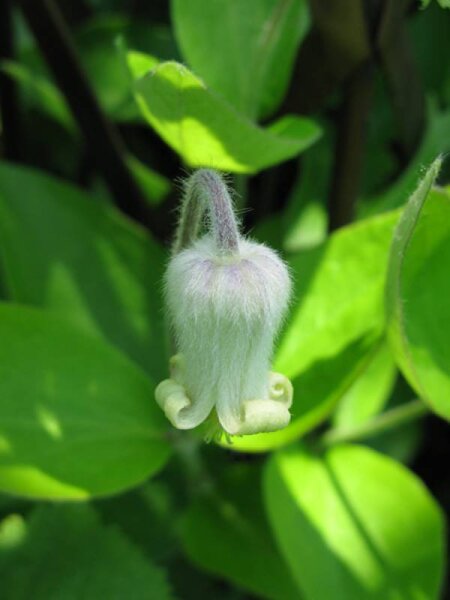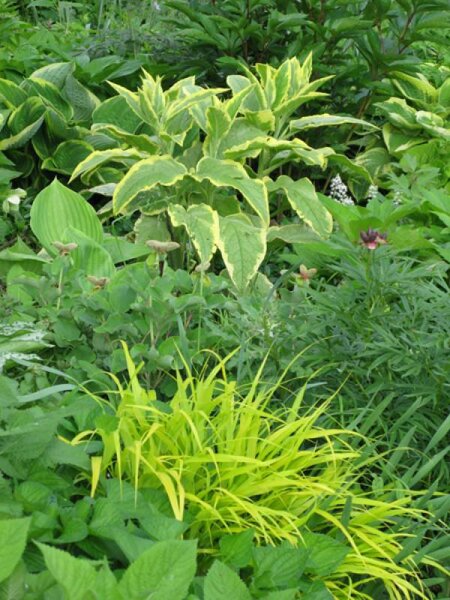Four more plants I can't live without
Loading...
I've been reflecting on which plants did well in previous years' gardens. My first list was Plants I can't live without, part 1. Then I sang the praises of a lamium that doesn't spread. Finally, I want to tell you about four more plants that are stars in my garden:
Clematis albicoma (whitehair leather flower)
Clematis albicoma [see Photo 1 at left] is the cute, adorable kitten in the world of my garden plants -- a charming little clematis species that is unaccountably rare in cultivation.
The captivating, pipsqueak of a plant, which grows a mere 18 inches high, is blessed with small -- less than 1 inch long – delightfully chubby, nodding, urn- shaped flowers. The white blossoms – often flushed with purple toward the base and covered with silken, downy hairs – appeal to my sense of whimsy.
Unlike its twining, climbing, and scrambling cousins, C. albicoma rises on erect stems, and the singular blooms, which start to flower for me in late spring through early summer, are truly appealing. Unfortunately, they are never produced in large enough numbers for my taste.
Native to parts of Virginia and West Virginia, the clump-forming clematis, hardy to Zone 5, grows best in sun to partial shade, in well-drained garden soil.
Syneilesis aconitifolia (shredded umbrella plant)
This is another woodlander that had me at hello!
First, this plant with the mouthful of a botanical name, Syneilesis aconitifolia (Sin-eel-ES-is a-kon-eye-tih-FOH-lee-uh), has an engaging common moniker – shredded umbrella plant. [See Photo No. 3 at left.] Then, the newly emerging leaves, looking like so many furry, silvered mushrooms, slowly morph into fuzzy, tattered parasols on their way to the final stage elegantly dissected umbrellas.
By midspring, the exquisite grayish-green foliage expands to 8 inches or so atop18- to 24-inch stems. In summer, insignificant white or purplish flowers on multiple stems appear above the leaves. Hardly showy, they are best dealt with a pair of pruners as soon as you see them for they really detract from the fantastic textural quality of the plant.
It’s a slow grower, taking a good five to seven years to form a 2-foot-wide mound, but if ever there was a woodlander worth waiting for, this is it. Shredded umbrella plant enjoys light shade and deep, humus-rich soil that does not dry out completely. Hardy in Zones 4 to 8.
Reminiscent of a mayapple (Podophyllum), this drool-worthy plant from Asia is one of those eye-catching foliage plants that plant nuts like myself, lust over for that “one-upmanship” over our gardening buddies.
Symphytum x uplandicum ‘Axminster Gold’ (Russian comfrey)
If you enjoy beautiful variegated foliage, and dream of tall, statuesque blonds in your landscape, then Symphytum x uplandicum ‘Axminster Gold’ is just the plant for you. [See Photo No. 2 at left.]
Think this gorgeous beauty is not a vixen? Think again. I don’t know of one gardener who wasn’t smitten at first glance. Best of all, this highly sought after, dramatic perennia, which produces an abundance of big, bold, somewhat hairy foliage without much fussing from the gardener, is getting so much easier to find at local nurseries.
Mind you, this is no ordinary, run-of-the-mill comfrey. ‘Axminster Gold’ – with its rough, long, elongated leaves of grey-green edged in wide creamy-yellow margins – is electrifying in any garden setting. But planted in the depths of the shady border, this non-invasive comfrey creates one heck of an exciting focal point.
In June, small, tubular, pale pink and purple blossoms drip in clusters from the upper axils of the tall (nearly four-foot) stems. While the plant as a whole is absolutely stunning, the flowers simply are not.
‘Axminster Gold’ is best grown in part shade or dappled sun, in moist, humus rich soil To prevent leaf edges from browning, a steady supply of moisture is mandatory, but should you slip up and the plant disappoints with discolored leaves, hack the whole thing back and water thoroughly to encourage a flush of new, healthy growth. (This process also works wonders for tidying up the clumps after flowering.)
Though I’ve read that the foliage may irritate the skin in some people, I haven’t found this to be an issue. Still, if you have sensitive skin, a word to the wise would be to wear gloves. Remove old leaves in the fall, but to prevent winter rotting, cut back the foliage only in the spring. Hardy in Zones 4 to 7.
Hakonechloa macra ‘Aureola’ (golden Japanese forest grass, golden Hakone grass) and Hakonechloa macra ‘All Gold’
Hakonechloa macra ‘Aureola’ is a Japanese grass, mostly valued in woodland and shady gardens for its cascading, dense clumps of arching, mostly golden yellow blades that evokes the movement of wind ruffling through the garden, even in still air. A new, exciting addition of this grass is ‘All Gold’ , a slightly more upright form than ‘Aureola.' It has luminous golden foliage. [See Photo No. 2 at left.]
As a container plant, golden hakone grass adds pure charm to any container, cascading over the sides like a frothy waterfall.
Growing 12 to 18 inches tall with a spread of about 24 inches, this truly handsome deciduous grass is never invasive. Individual blades are rather narrow and bright yellow with very thin green stripes. In the cooler days of fall, the foliage becomes tinged with shades of pink and red.
If hakone grass has a flaw, it’s that it is an extremely slow grower, taking years to create that dense, mounding look for which it is so famous. As much as it pains me sometimes, I always purchase as mature a plant as I can afford.
Hardy to Zones 5 to 9, golden hakone grass, a bewitching companion to various burgundy, blue or dark-purple hosta and heuchera cultivars, grows best in rich, moist, and well-drained acidic soils. Although it needs some sun to maintain the golden coloration, it prefers a permanent place in light shade.
Although the grass is famous for its deer resistance, in my garden, nevertheless, there is an ongoing battle with rabbits, which pounce upon it with a greedy relish. Still, I’m addicted!
Betty Earl is one of eight garden writers who blog regularly at Diggin' It. She's the author of “In Search of Great Plants: The Insider’s Guide to the Best Plants in the Midwest,” is one of eight garden writers who blogs regularly at Diggin' It. She also writes a regular column for Chicagoland Gardening Magazine and The Kankakee Journal and numerous articles for Small Gardens Magazine, American Nurseryman, Nature’s Garden, and Midwest Living Magazine, as well as other national magazines. She is a garden scout for Better Homes and Gardens and a regional representative for The Garden Conservancy.
Editor’s note: To read more by Betty Earl, click here. For more Monitor gardening, see our main gardening page and previous posts of Diggin' It [they're there if you keep scrolling down]. Both of these have new URLs, so we hope you'll bookmark them and return. Want to be notified when there's something new in our gardening section? Sign up for our RSS feed.






